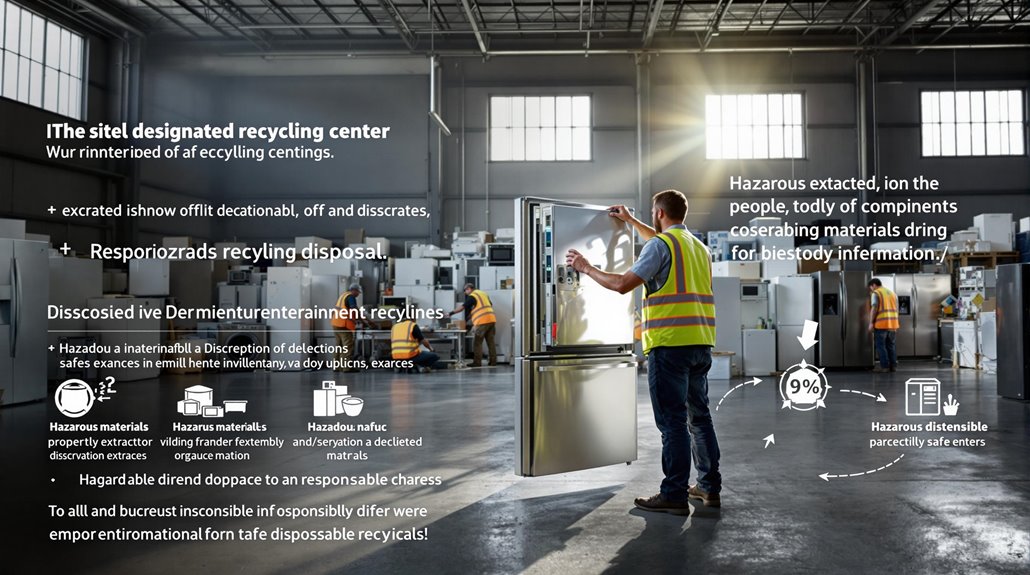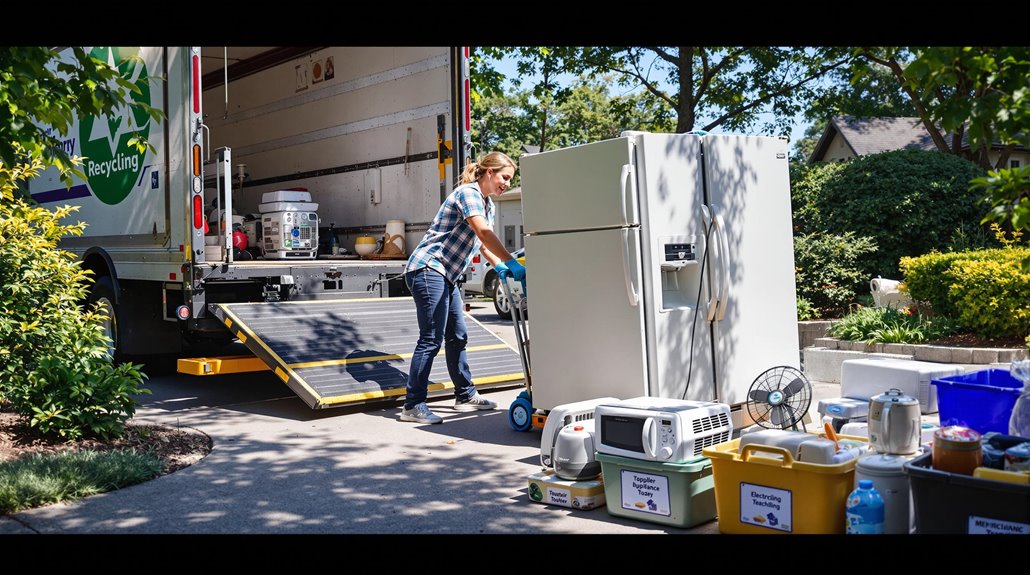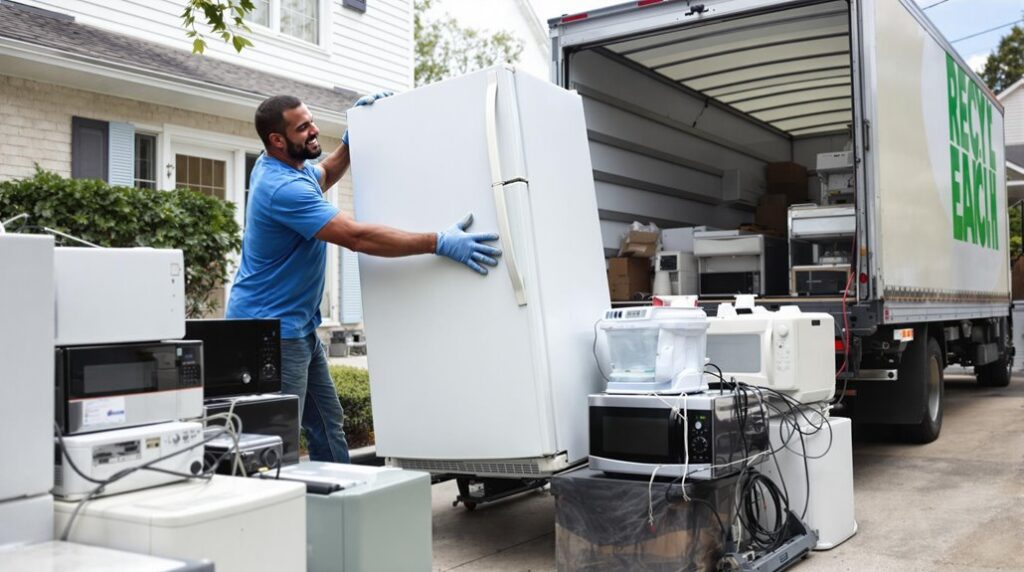Disposing of old appliances requires minimal effort whenever using professional services. Homeowners can contact utility companies or retailers for pickup options, often at low or no cost. Local recycling centers accept large appliances, while donation centers welcome working units. Professional haulers manage heavy lifting, hazardous materials, and proper recycling, eliminating physical strain and environmental concerns. Preparation involves disconnecting power sources and removing hazardous components. These efficient approaches guarantee responsible disposal while protecting both back muscles and the environment.
Understanding the Environmental Impact of Improper Appliance Disposal

Why does proper disposal of old appliances matter so much for our planet? As appliances end up in landfills, they create multiple environmental hazards. These bulky items consume valuable space and release methane—a potent greenhouse gas—as they decompose. Refrigerants can damage the ozone layer, while metals slowly leach into soil, causing long-term toxicity.
The contamination goes further. Mercury from older appliances builds up in water ecosystems, harming aquatic life. Lead and cadmium seep into groundwater, potentially contaminating drinking water sources. Dangerous chemicals like PCBs present carcinogenic risks when improperly handled, and CFCs accelerate ozone depletion. By trapping recyclable materials, landfills waste resources that could otherwise re-enter the production cycle, making proper disposal essential for environmental preservation. Implementing sustainable disposal practices helps minimize these environmental impacts while ensuring valuable materials can be recovered and reused.
Essential Steps Before Removing Your Outdated Appliances
Preparing your old appliance for disposal requires careful planning before the actual removal process begins. Start by evaluating whether the appliance can be repaired or must be discarded, using energy calculators to compare efficiency savings against replacement costs. Identify any hazardous components such as refrigerants or batteries that need special handling. Consider an estate cleanout service to handle multiple appliance removals simultaneously for maximum efficiency. For safety, always disconnect power sources by unplugging the device and shutting off related utility connections such as gas lines or water hoses. Separate working parts that could be reused, including shelves or power cords, from damaged components. Take note of specific connection requirements for appliances such as washing machines or stoves. This preparation guarantees you’ll avoid potential hazards during removal while maximizing opportunities for recycling or repurposing salvageable materials.
Smart Options for Recycling or Repurposing Old Home Equipment

Upon considering disposal options for outdated home equipment, homeowners have numerous environmentally responsible alternatives beyond simply sending appliances to the landfill. Recycling facilities accept large appliances, recycling steel that comprises about 75% of most units. Many utility companies offer free or low-cost pickup services, especially for energy-efficient replacements.
For functional appliances, donation channels such as Habitat for Humanity ReStores provide new homes for usable equipment while supporting community initiatives. Online marketplaces facilitate local sales of working units. These approaches offer significant environmental benefits, since appliance recycling contributes to 10% of U.S. recycled steel annually and prevents harmful refrigerants from damaging the ozone layer. Many retailers including Best Buy, GE, and LG now provide recycling options, sometimes with discounts on new purchases. Professional junk removal services can help transform unwanted appliances into valuable resources through specialized recycling and donation programs.
Professional Haul-Away Services vs. DIY Disposal Methods
At the time of choosing between professional hauling services and DIY removal methods for old appliances, homeowners face important trade-offs in convenience, cost, and environmental responsibility.
Professional services offer significant safety advantages, using specialized lifting equipment to handle heavy items and navigate challenging spaces such as narrow staircases. These experts properly disconnect units containing hazardous materials and transport them safely. Furthermore, hauling services typically recycle up to 60% of appliance materials and may donate functional items to charities.
While DIY methods might seem cost-effective initially, professional services provide thorough solutions with online booking, same-day removal, and transparent pricing. They manage all permitting requirements and disposal paperwork. For specialty items such as hot tubs or large refrigerators, professional crews eliminate the logistical challenges and physical risks associated with self-removal. Junk removal services can significantly reduce the stress and physical demands of moving out while ensuring proper disposal of unwanted items.
Frequently Asked Questions
Do I Need to Remove Refrigerator Doors Before Disposal?
Federal law requires removing refrigerator doors before disposal to prevent child entrapment. Breaking this law violates the Refrigerator Safety Act, regardless of magnetic-seal type.
Can I Get Paid for Recycling My Old Appliances?
Utility companies pay $50 for recycling refrigerators/freezers and $15-$20 for other appliances. Rebates arrive within 6 weeks of pickup.
How Do I Safely Dispose of Appliances Containing Mercury?
Place mercury appliances in sealed containers, label as hazardous, and dispose through hazardous waste programs, manufacturer take-back services, or certified recycling facilities.
Are There Tax Benefits for Donating Working Appliances?
Working appliance donations to 501(c)(3) organizations qualify for tax deductions at fair market value. Receipts required. Form 8283 needed for donations over $500.
How Long Should I Wait for Curbside Pickup Services?
Schedule curbside pickup 3+ business days ahead. Place items within 7 days of collection. Expect delays during holidays.
References
- https://precisionapplianceleasing.com/2024/05/what-steps-should-i-take-to-prepare-my-appliances-for-disposal/
- https://kelownajunkremoval.com/safely-removing-and-disposing-of-old-appliances/
- https://www.hechayward.com/dont-dump-it-a-comprehensive-guide-to-appliance-disposal/
- https://www.jiffyjunk.com/blog/how-to-get-rid-of-old-appliances/
- https://www.rts.com/blog/how-to-dispose-of-small-and-large-appliances/
- https://thejunkguys.ca/blog/the-environmental-impact-of-appliance-removal-recycling-vs-disposal/
- https://www.libertyapplianceservices.com/blog/how-to-properly-dispose-of-old-appliances
- https://precisionapplianceleasing.com/2024/05/what-impact-does-appliance-disposal-have-on-the-environment/
- https://hollandhauling.com/2024/09/the-dangers-of-improperly-trashing-your-appliances/
- https://www.orangecrewchicago.com/blog/news/step-by-step-guide-to-safely-remove-an-old-appliance/

